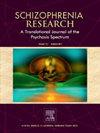Dynamic interactions among schizotypal traits, affective and prodromal symptoms, social functioning in a large sample of college students: A cross-lagged panel network analysis
IF 3.6
2区 医学
Q1 PSYCHIATRY
引用次数: 0
Abstract
Objective
Previous studies suggested that schizotypal traits are closely related with affective symptoms and social dysfunction in general population. However, the dynamic interactions among these variables across time remain unclear. This study aimed to investigate this issue using cross-sectional and longitudinal network analysis.
Methods
A total of 9136 college students completed self-report scales measuring schizotypal traits, anxiety, depression, prodromal risk, and social functioning at timepoint 1 (T1) and six months later. Classical contemporaneous network analysis was used to estimate the associations among all variables at T1, and the cross-lagged panel network analysis was performed to estimate the predictive effects at follow-up. In addition, prodromal high-risk and low-risk subgroups at T1 were identified using Prodromal Questionnaire (PQ-16) to investigate differences on network constructs and edge weights using Network Comparison Tests (NCT).
Results
Contemporaneous network showed that negative dimension of schizotypal traits, anxiety, and depression interacted and were all negatively correlated with social functioning. Of all the nodes in the network, interpersonal features of schizotypal traits was the most centralized. The results of cross-lagged network analysis further verified the predictive effect of personality traits and emotions on social function. In addition, NCT revealed significant difference between prodromal high-risk and low-risk subgroups in network structure and strength of edges connecting schizotypal traits, affective symptoms with prodromal risk, but not in global strength.
Conclusions
Our findings suggest that schizotypal traits, affective symptoms, and prodromal risk relate to social functioning, both independently and through their dynamic interactions.
求助全文
约1分钟内获得全文
求助全文
来源期刊

Schizophrenia Research
医学-精神病学
CiteScore
7.50
自引率
8.90%
发文量
429
审稿时长
10.2 weeks
期刊介绍:
As official journal of the Schizophrenia International Research Society (SIRS) Schizophrenia Research is THE journal of choice for international researchers and clinicians to share their work with the global schizophrenia research community. More than 6000 institutes have online or print (or both) access to this journal - the largest specialist journal in the field, with the largest readership!
Schizophrenia Research''s time to first decision is as fast as 6 weeks and its publishing speed is as fast as 4 weeks until online publication (corrected proof/Article in Press) after acceptance and 14 weeks from acceptance until publication in a printed issue.
The journal publishes novel papers that really contribute to understanding the biology and treatment of schizophrenic disorders; Schizophrenia Research brings together biological, clinical and psychological research in order to stimulate the synthesis of findings from all disciplines involved in improving patient outcomes in schizophrenia.
 求助内容:
求助内容: 应助结果提醒方式:
应助结果提醒方式:


